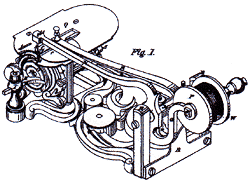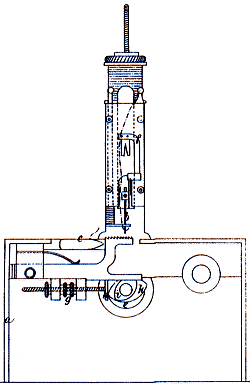


|
Four
motion feed.
Always
viewed as one of the key features of sewing machine development,
the four motion feed is considered one of Allen B. Wilson's finest
innovations. The relevant USA patent is dated 19th December 1854. |
| It
turns out that Wilson had substantially described such a feed mechanism
in a previous submission that predated the Grover & Baker '52
one. Wilson's famous 1852 stationary bobbin patent is the one we are concerned with here. The principle of the feed is well described within the main body of the patent, but perhaps the problem lay in the fact there was no mention of the feed mechanism in his final summation. Now, I am no expert in the legalese of such matters, but I would have thought the omission to specify the four motion feed element a grave oversight by Wilson. |
Barbara
Janssen of the Smithsonian |
| Regrettably
I have not been able to view documentation of any subsequent challenges
that were made on this issue. Without further contemporary evidence, what are we left with? It might appear that Grover and Baker simply pinched Wilson's described idea, and patented it for themselves later that same year. The problem with this is that Grover and Baker's patent was sealed just seven days after Wilson's. Logically, it seems hard to believe that Grover and Baker could have seen a copy of Wilson's new patent, drawn up their own, and have it submitted and granted all within one week. It's worth remembering that Grover and Baker's patent also contains the other significant modifications to their own machine, which they would have wanted to patent anyway. (Unfortunately, US patents of this period only give the approved date, unlike UK patents, which also show "applied for" dates. I believe very dusty records do still exist in the USA, which contain information on submission dates, etc., but these are not easily accessed.) Could it just be that Grover and Baker, and Wilson conceived the principle of four motion feed at approximately the same time, it was after all a period of very rapid sewing machine development. A second and far more plausible explanation could be that Wilson was in fact marketing a machine which incorporated the new feed some time before his '52 patent was submitted. Messrs. Grover and Baker, after possibly seeing a production machine, had then seized upon this feature as one of great potential and decided to patent it for themselves. |
| Whatever
the arguments at the time were, it's clear that Wilson won the day,
albeit well over two and a half years after the debacle first occurred,
for as we know in late 1854 he specifically patented his four motion
feed. Wilson's closing summary ironically mimicked Grover and Baker's
earlier one almost word for word. History clearly shows a settlement was eventually reached, but it's worth noting that four motion feed machines were produced in substantial numbers from 1852 - not only in the USA, but also Britain. If
anyone has any contemporary copy regarding this particular episode,
I would be glad to add it here……. G.D. |
C.T.Judkins'
"hybrid" machine was |
© All content copyright protected.

